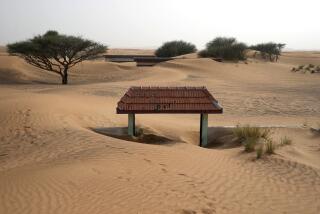An Ancient Garden of Eden Is Unearthed in Persian Gulf’s Bahrain
- Share via
SAAR, Bahrain — In ancient times, the land of Dilmun was described as a virtual Garden of Eden, a land where the wolf and the lamb lived in harmony and youth was eternal.
Archeologists today are uncovering more of that once-fabled land, revealing a prosperous trading society that had such abundant supplies of water that palm trees grew heavy with dates almost without effort.
“Fresh water just bubbled up out of the ground,” said Jane Moon, one of the directors of the archeological expedition at Saar. “That must have been miraculous to Gulf people.”
Saar was one of the towns in ancient Dilmun, which at different times encompassed what is now the Persian Gulf island of Bahrain and parts of eastern Saudi Arabia.
In about 1900 BC, Saar was one of several bustling towns in Bahrain apparently ruled from a city whose ruins are beneath a medieval fort six miles to the northeast.
Merchants in the area grew rich as ships laden with copper from Oman stopped in Dilmun while traveling up the Persian Gulf to Babylon in Mesopotamia, which is in modern-day Iraq. The copper was later mixed with tin or lead to form bronze weapons and tools.
“This very small island . . . suddenly got hold of a somewhat monopolizing role,” said Dan Potts of Australia’s University of Sydney.
Dilmun was famous for its dates, which were popular in a region where the fruit remains common. Pearls, believed to have been called “fish eyes” in Mesopotamia, were also traded. In modern times, Bahrain had a famous pearling industry.
Dilmun achieved everlasting fame in Mesopotamian religious texts, where it was lauded in mythological terms.
One text says:
In Dilmun, the crow screams not,
the dar bird cries not dar-dar,
the lion kills not.
Archeologists say the same text shows the Mesopotamians viewed Dilmun as a land of eternal youth:
Its old woman says not, “I am an old woman.” Its old man says not, “I am an old man.”
Some experts say Dilmun’s role as a port where ships took on food and water may have led to its glorified image among the Sumerians and later the Babylonians.
“There really was the opportunity to pick up lifesaving sustenance there,” said Gordon Davis of the University of Alabama.
Potts notes that Dilmun myths predated major Bahrain settlements and may have referred to earlier Dilmun communities in today’s Saudi Arabia.
The ruins of Saar--the only complete town found from the Dilmun period--show some 80 stone houses, almost all with two rooms and a courtyard. It is not clear how many people lived in each room.
Next to the town is a graveyard with about 1,000 tombs. Bahrain is famous for having up to 150,000 burial mounds, but it’s unclear why so many exist.
At Saar’s highest point sat a small temple for worship of local gods that probably also was used as an administrative center.
In March, Moon’s team unearthed a kitchen, which had a bread oven and a fireplace with supports for a cooking pot. The people most likely ate dates, fish and gazelle meat. About 85% of bones found at the site were from fish.
The town was abandoned in about the 17th century BC for reasons that remain a mystery.
Moon theorizes a receding coastline prompted people to abandon the site. Potts says an interruption in the copper trade or changes in the water supply may have caused the town’s demise.
More to Read
Sign up for Essential California
The most important California stories and recommendations in your inbox every morning.
You may occasionally receive promotional content from the Los Angeles Times.













